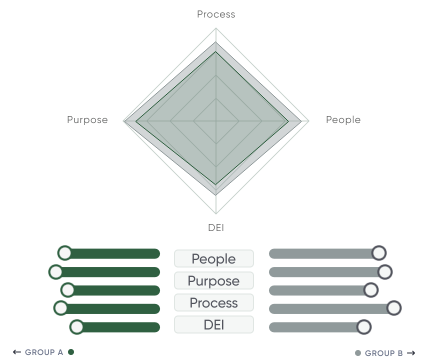The 5 Patterns Keeping Good Teams from Getting Unstuck

Related Insights
Even high-performing teams hit walls. Here’s how to move forward with the intention to achieve your best work.
Building high-performing teams isn't just about assembling talented team members and setting a shared vision or common goals. You can have exceptional individuals, a compelling mission, and still feel like something's not clicking in your team dynamics.
Most teams don't need fixing. They need intentionality around their team culture, how they approach decision-making together, and what kind of work environment they want to create.
Here are five of the most common challenges teams can encounter, even with those who have relationships, meaningful work, and strong impact.
1. Mistaking Activity for Alignment
Busy calendars filled with meetings and lengthy to-do lists can create the illusion of momentum and initiative. But without effective communication about how and why you're moving, team members are just spinning their wheels without any clear or shared goals. This trap often reveals itself in metrics that show productivity but not progress.
Try this: In your next team meeting, pause the updates and ask: "What are we trying to move forward together? And, do our diverse perspectives actually align on that?"
2. Underestimating the Need for Connection
Some teams default to a task-first mindset in their work environment. Get the work done, don't make it personal. But underneath, team members are deeply invested, and when that emotional commitment goes unnamed, it becomes impossible to build trust and maintain open communication.
Try this: At your next check-in, ask: "What's something about this work—or this team culture—that really matters to you right now?"
When emotional investment is acknowledged through effective communication and constructive feedback, teams transition from simple task completion to a true partnership and shared goals, thereby enhancing overall team dynamics.
3. Leaving Decision-Making Processes Unspoken
Many teams have clarity on roles and goals, but often operate on unspoken assumptions about problem-solving, accountability, and conflict resolution. Over time, this vagueness creates tension that undermines team cohesion and success.
Try this: Foster open communication by asking: "What are the unspoken rules guiding our decision-making—and are they serving our team culture?"
Better yet, co-create these processes together. You can't improve team dynamics in a cross-functional system you've never discussed. Consider mentoring newer team members on these evolving norms.
4. Believing "Fine" Is Good Enough for Team Success
"Nothing's really broken" can be a dangerous narrative for building high-performing teams. It keeps team members from addressing deeper issues and limits their potential for meaningful, innovative problem-solving. Without continuous learning and improvement, teams plateau and development and progress suffer.
Try this: Invite your team to brainstorm by asking: "What's one area where we could shift from simply functinf to actually thriving in our teamwork?"
Teams often have glimpses of exceptional collaboration, but they just haven't named or nurtured them through intentional team-building yet.
5. Overlooking the Cost of Stagnant Team Culture
Doing nothing has measurable costs in any work environment. The friction of misalignment shows up in metrics: energy lost in rework, turnover from quiet burnout, and missed opportunities for leveraging diverse perspectives. Staying static may feel easier, but continuous improvement is essential for every successful team.
Try this: Share the Team Styles Model with your team members and ask: "Where do we think we are currently in becoming a high-performing team? Where would we like to be? How can we become a more effective team?"
This simple question can unlock unmet team needs and create a powerful shared commitment to achieving team development through high-quality, continuous learning.
A Different Way to Work Together Is Possible
The teams that achieve lasting success aren't the ones that never struggle. They're the ones that pause long enough to reflect, realign, and reset their approach to how the work gets done and achieving team goals. They prioritize connection, embrace diverse perspectives, and commit to continuous improvement in their decision-making processes.
We designed the Team Styles Model to support this journey—to help you name how your team is currently operating, and how you can create momentum toward building a connected, aligned, and high-performing team.








